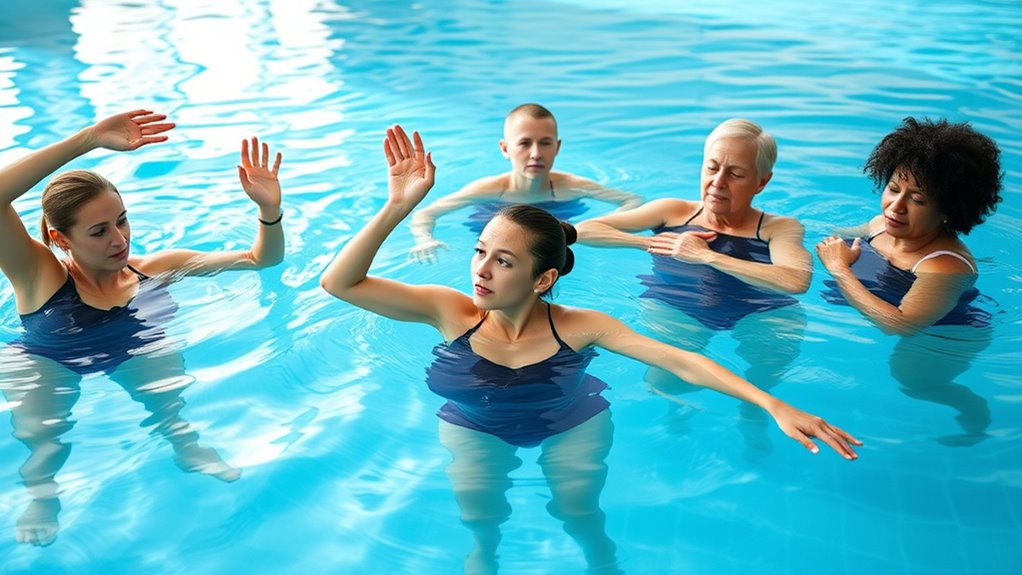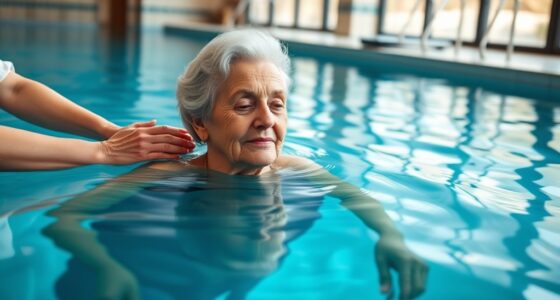Discover inspiring water therapy success stories where individuals regain mobility and confidence after injuries. Many find relief through low-impact exercises like water walking and gentle stretches in warm water, which relax muscles and boost healing. These stories show how patience and consistency transform pain into strength, often inspiring others to embrace the healing power of water. Keep exploring to see how water therapy can help you overcome your own challenges and restore your energy.
Key Takeaways
- A professional athlete recovered from a knee injury using water therapy, regaining full mobility and returning to competition within months.
- An elderly patient overcame chronic joint pain through warm water exercises, restoring independence and improving quality of life.
- A stroke survivor utilized aquatic exercises to rebuild strength and coordination, achieving significant progress in mobility and confidence.
- A postoperative patient experienced accelerated healing and reduced scarring by incorporating targeted water resistance routines into rehab.
- A young athlete with a sports injury regained full range of motion and strength, thanks to customized aquatic therapy sessions.

Water therapy has transformed countless lives by promoting healing, relaxation, and renewed energy. If you’re recovering from an injury or managing chronic pain, you’ve probably heard about the incredible hydrotherapy benefits. This approach uses the natural properties of water—buoyancy, resistance, and temperature—to support your body as you work toward recovery. One of the key reasons it’s so effective is the variety of aquatic exercise techniques available, which allow you to target specific muscles, improve flexibility, and rebuild strength without putting undue stress on your joints. Whether you’re dealing with a sports injury, arthritis, or post-surgical recovery, water therapy offers a safe and motivating environment.
Water therapy uses water’s natural properties to promote healing, improve flexibility, and rebuild strength with low joint stress.
When you start exploring hydrotherapy benefits, you quickly realize that the water’s buoyancy reduces the weight on your joints and spine. This reduction means you can perform movements that might be painful or impossible on land. For example, walking or jogging in water becomes a low-impact workout that minimizes strain while still providing effective cardiovascular benefits. Additionally, the resistance of water makes your muscles work harder with less effort, helping you rebuild strength faster. This resistance is adjustable based on how you move, so whether you’re doing gentle stretching or more intense exercises, you can tailor your sessions to your needs.
Aquatic exercise techniques serve as a cornerstone of successful recovery. You might begin with simple water walking or gentle range-of-motion exercises, gradually progressing to more challenging routines as your strength improves. Many therapy programs incorporate specific movements to target areas affected by injury, ensuring that your rehab process is both focused and efficient. The water’s thermal properties also play a crucial role—warm water helps relax tight muscles, increase circulation, and reduce pain, making each session more comfortable and effective. As you become more confident, you’ll find that these techniques not only accelerate healing but also boost your motivation to stay committed to your recovery plan. Incorporating water resistance training can further enhance muscle strength and endurance during recovery.
Over time, you’ll likely notice increased mobility, decreased pain, and a renewed sense of confidence. The combination of hydrotherapy benefits and aquatic exercise techniques creates a supportive environment where you can push your limits safely. This empowering process enables you to regain independence and return to daily activities with less discomfort. Many individuals have shared inspiring stories of how water therapy turned their injury setbacks into stories of resilience and strength. As you set out on your own journey, remember that patience, consistency, and embracing the unique properties of water can lead to extraordinary recovery outcomes.
Frequently Asked Questions
What Are the Initial Signs Indicating Water Therapy Might Help?
When starting water therapy, you might notice initial discomfort or muscle stiffness, which is common as your body adapts. These signs indicate that your muscles are responding and beginning to loosen up. If you feel relief or increased flexibility over time, it suggests water therapy is helping. Trust your body’s signals—progress often starts with these early signs, showing that you’re on the right path to recovery or improved strength.
How Long Does Recovery Typically Take With Water Therapy?
Time will tell, but recovery duration with hydrotherapy varies. You might see improvements in a few weeks, or it could take months, depending on your injury’s severity and your commitment. Hydrotherapy timelines are flexible; some experience faster progress, while others need more patience. Generally, consistent sessions accelerate healing, so stay dedicated and trust the process. Your body’s response will ultimately determine how long recovery takes.
Are There Age Restrictions for Water Therapy Programs?
Age limitations for water therapy programs vary depending on the facility and program specifics. Generally, senior programs are designed specifically for older adults, but many centers welcome participants of all ages. If you’re considering water therapy, check with the provider about age restrictions and available senior programs. These programs adapt exercises to suit different needs, ensuring safe and effective recovery or fitness, regardless of age.
Can Water Therapy Be Combined With Other Rehabilitation Methods?
You might worry about whether water therapy can stand alone, but it’s actually highly effective when combined with other rehab methods. Hydrotherapy techniques, like aquatic exercise, complement physical therapy and medication, accelerating recovery. Imagine seamlessly integrating these methods, using water’s natural resistance to boost strength and flexibility. This combined approach offers a personalized, holistic plan that enhances healing, making your journey to recovery more efficient and enjoyable.
What Are Common Challenges Faced During Water Therapy Recovery?
During water therapy recovery, you might face challenges like maintaining patient motivation, especially when progress feels slow. Water temperature can also impact your experience; if it’s too cold or too hot, it may cause discomfort or reduce effectiveness. Staying consistent and communicating with your therapist can help you overcome these obstacles, ensuring you stay motivated and comfortable throughout your recovery journey.
Conclusion
As you reflect on these stories, it’s remarkable how water therapy often arrives just when you need it most, almost as if fate orchestrates the timing. These journeys remind you that recovery isn’t always linear, and sometimes, the smallest drop of hope can lead to profound healing. Trust in the process and stay open to unexpected blessings—because, like water, resilience finds its way through even the toughest obstacles.









